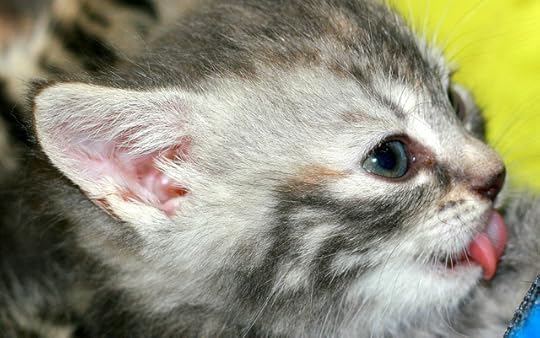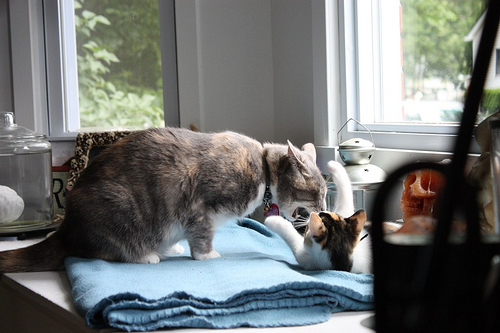Newborn Kitten Development
Turn about is fair play–the blog discussed newborn puppy development last Wednesday so today we look at the cat-egorical side of things. Besides, it’s a great opportunity to share SQUEEE! cute kitten pictures!

Kittens begin self-grooming as early as 3 weeks of age. Image Copr. Maria Magnus via Flickr
Did you get a kitten over the holidays? Or maybe you rescued a bottle-baby orphan or are fostering a kitten for your local pet rescue. Here are a few things to keep in mind, but you’ll find a lot more detail in the kitten book, of course.
When your kitten was born, he measured four to six inches long and weighed only two to four ounces. He was blind, deaf, toothless, and just like baby dogs, unable to regulate his own body temperature to stay warm. At this age, kittens depend on touch, sense of smell, and thermal sensation to find Mom and food, and they move by wriggling their bodies from side to side.
Week old kittens spend four hours a day suckling, and more than 16 hours sleeping. They begin to move more easily, and look like swimmers paddling across the bedding. By this age, the body’s shiver reflex develops, and that means they are better able to regulate temperature and keep themselves warm.
Their eyes begin to open between nine to 12 days of age, and babies learn to recognize Mom and others as friends or foe. Ears begin to unseal about this same time and the first baby teeth appear.
By age three week kittens start to clumsily play with each other, follow Mom around, learn about the litter box, and are now able to retract their claws. They start to watch Mom and mimic her by self-grooming themselves. Hey, there’s a reason they call it “copy cat behavior.”
What kittens experience beginning at this age will have a huge impact on how well-adjusted (or not) they become as adults. Kittens handled a few minutes daily by people during their first month of life have an improved learning ability.
By week four, Mom’s milk production starts to decrease just as the kitten’s energy needs grow. Curiosity and hunger spur the babies to sample Mom’s solid food.
By this age, kittens understand the concept of the litter box from watching Mom. However, they still have a limited capacity for “holding it” and may have accidents when the box isn’t close enough to accommodate their needs. They continue to develop physically. The rest of the baby teeth come in, including needle sharp canine teeth.

“I said STOP IT ALREADY!” Image Copr. Florence Ivy via Flickr
Social play with Mom and siblings begins now, and includes running, rolling, biting, wrestling, climbing, and jumping. Mom-cat and siblings let the baby know if he bites or claws too hard and they’ll hiss at him or put an end to the game. If you are the “mother figure” it’s up to you to teach Baby about the litter box, playing “nice” and eating grown-up food.
Kittens gain two to four ounces a week from birth to five to six months of age. The kitten immune system is also fully developed by six to eight weeks of age, while the immune protection he gained from Mom begins to fade.
Play and interaction with others takes over during weeks five to seven. Good experiences with people and other pets during this time ensure they’ll be well-adjusted adult cats. It’s ideal for kittens to stay with their littermates and mother until twelve weeks of age so they learn best how to get along with other cats, and learn all the important “cat rules” of the world. But very often, shelters need the space and adopt out babies earlier–or the kitten is alone in the world anyway, and benefits from being adopted earlier.
When you adopt a kitten at this age, it’s up to you to expose him to a wide range of situations so he’ll be willing to accept them as he ages. That’s called “socialization” and can mean the difference between a loving pet and a scaredy cat.
He should learn to accept being handled and groomed by you and strangers, so the veterinarian won’t have to fight him for an examination. This is the best age to train him to accept the cat carrier and leash. That allows him to travel with you when necessary, either to the vet or groomers, or across town to visit Grandma. And if you think another pet (dog or cat), or a child might be in your future, introduce him to positive experiences at this age. That way, he’ll accept them as a normal part of his world and you’ll prevent behavior problems down the road.
How hold was your cat when you adopted him? Have you ever needed to hand-raise a kitten? What do you think is the best age to adopt–and why? Please share!
I love hearing from you, so please share comments and questions. Do you have an ASK AMY question you’d like answered? Do you have a new kitten and need answers? Stay up to date on all the latest just subscribe the blog, “like” me on Facebook, listen to the weekly radio show, check out weekly FREE PUPPY CARE newsletter, and sign up for Pet Peeves newsletter. Stay up to date with the latest book give aways and appearances related to my THRILLERS WITH BITE!
Filed under: Cat Behavior & Care Tagged: Amy Shojai, cat care, complete kitten care book, kitten development, kitten socialization, www.amyshojai.com





